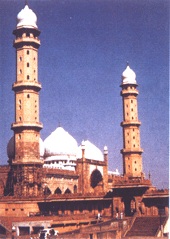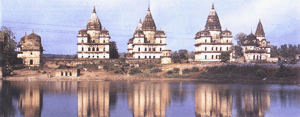|
The
northernmost city, is an excellent entry point. It was
established in the 18th century A.D. and named after saint
Gwalipa. The city is dominated by its hill-top fort, one of
the most redoubtable in the world. Rajput valour and chivalry
are redolent in the very stones of the 15th century palace of
Raja Man Singh located in the citadel.
General
information
|
Altitude |
212
meters |
|
Best Season |
October to March. |
|
Temperature |
Summer : Max 46 Deg. 21
Deg.; Winter : Min 22 Deg. 6 Deg |
|
STD Code |
0751 |
How
to get there
Air
Gwalior
is connected with Delhi, Bhopal, Indore, Bombay.
Rail
Gwalior is
connected to all major cities in India.
Road
Gwalior
is well connected by good roads. Certain important road
distances are Agra 118 km, Bhopal 420 km, Delhi 318 km,
Khajuraho 280 km, Sanchi 344 km, Shivpuri 112 km, Indore 486
km.
In
and around
Gwalior Fort
Gwalior Fort made of sand stone, is a magnificient monument. A
steep road winds up wards to the fort which is flanked by
statues of many Jain Tirthankaras. The outer walls, 3 km in
length and 35 ft. high, stand as a witness to its reputation
as an invincible structure. There is a sound-and-light show
here in the evenings.
Gujari
Mahal
Gujari Mahal situated in the fort premises, is a 15th century
monument built by Raja Man Singh Tomar for his Gujar Queen,
Mrignayani. The inner portion has been converted into a museum
which houses antiquities going back to the 1st century A.D.
 Man
Mandir Palace Man
Mandir Palace
Man Mandir Palace was built by Raja Man Singh between
1486-1517. nearby is a Jawahar Pond, where, according to
Rajput tradition, queens used to commit 'Sati'. Suraj Kund was
built in the 15th century. However, reference to this gigantic
structure can be traced back to 425 A.D. Teli ka Mandir and
Sas Bahu ka Mandir are devoted to Lord Vishnu. The 9th century
Teli Ka Mandir, towering 100 ft high, is a pratihara Vishnu
temple with a unique blending of various architectural
styles-Dravidian, as well as Indo - Aryan.
Jai
Vilas Palace
Jai Vilas Palace is residence of the sindhia family. About 35
rooms have been converted into the Jevaji Rao Sindia museum.
The architectural is a combination of Italian, Tuscan and
Corinthian style.
Tombs
of Tansen
Tombs of Tansen is a memorial to the pillar of the Hindustani
music, Tansen. The tomb is a part of Gwalior's cultural
heritage. An annual national music festival is held here in
Nov-Dec.
Ghaus
Mohammad tomb
Ghaus Mohammad tomb, a mausoleum of the Afghan Prince.
Sonagiri
The 108 Jain temples date back 1,500 years, all arranged on
the steps of a hill. The main temple (57) on top of the hill
is in honour of the 8th Trithankara. One can walk up on paved
path ways to see the temples. Aarti is performed in the main
temples between 6-9 p.m daily.
Datia
The main sight in this town is the 7- storied palace of Raja
Bir Singh Deo, built atop the hill. Other sights are temple
with Mughal Frescoes, Gopeshwar temple and the Tantrik Peeth
of Pitambar Devi.
The
Narwar Fort
Capital of Raja Nala. The place is mentioned as Nalpura (Nala's
town) in a number of medieval sanskrit inscriptions. The
Narwar Fort is 500 feet above the surrounding country. Though
it is now in a dilapidated condition, yet judging from the
remains it seems likely that in the flourishing days it might
have been second to the Gwalior Fort in magnificence. The
architecture of the remains is Rajput in style with flat
ceilings, fluted columns and arches. Near the fort are the Jai
Stambha, Sati monument, Ladu Bungalow, Chhip Mahal, Makardwaj
Tal, Kacheri mahal, Sikandar Lodi's Mosque, Jail Kambha.
Orchha
|







